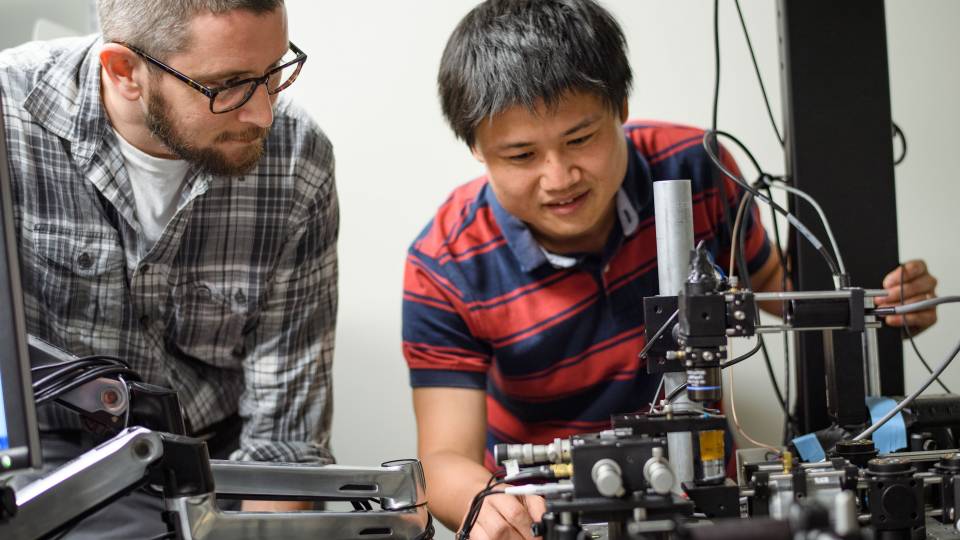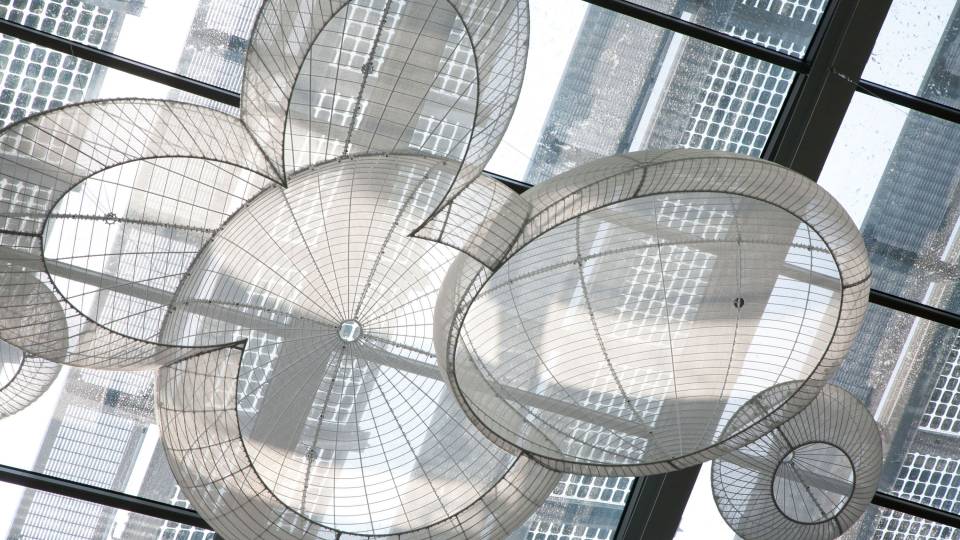Two new research technologies — a microscope for probing bacterial biofilms and an instrument to measure the properties of ultrathin plastics — have been awarded funding at Princeton University through the Eric and Wendy Schmidt Transformative Technology Fund.
Established in 2009 by Google executive chairman Eric Schmidt, a 1976 Princeton alumnus and former trustee, and his wife, Wendy, the fund supports projects with the potential for broad impacts on research in the natural sciences or engineering. The fund aims to foster technologies that have the capacity to transform entire fields of inquiry but may be considered too risky or forward-looking to obtain funding from traditional sources.
"Princeton's innovative thinkers are pushing the frontiers of knowledge through the development of novel research tools," said Princeton's Dean for Research Pablo Debenedetti, the Class of 1950 Professor in Engineering and Applied Science and professor of chemical and biological engineering. "We are fortunate that, with the generosity of the Schmidt family, the University is able to support truly pioneering and boundary-pushing endeavors."
A microscope for probing bacterial films
Experts at the art of self-preservation, bacteria can grow into sheets known as biofilms that prevent antibiotics from getting to where they are most effective, clog implanted medical devices, and foul up water filters and pipes. A better understanding of how bacteria create biofilms could lead to ways to improve health and the environment.
The Schmidt award in the amount of $823,000 will support the development of a tool to explore bacterial biofilms: a microscope capable of seeing inside the slimy mantle and interrogating its cells to find out which genes make them so successful.
"We want to ask, at the single-cell level, what chemical and physical and mathematical rules are underpinning the assembly of these films, and then we want to do something about it," said Bonnie Bassler, the Squibb Professor in Molecular Biology. Bassler is co-leading the project with Ned Wingreen, the Howard A. Prior Professor of the Life Sciences, and Howard Stone, the Donald R. Dixon '69 and Elizabeth W. Dixon Professor of Mechanical and Aerospace Engineering.

Princeton researchers, from left, Ned Wingreen, Bonnie Bassler and Howard Stone have received a Schmidt fund for developing a microscope to explore bacterial biofilms. (Photo by Denise Applewhite, Office of Communications)
When forming a biofilm, bacterial cells secrete a starchy substance that acts as a structural support and glue. The production of this polysaccharide matrix is coordinated through signaling molecules passed from cell to cell, a process called quorum sensing that is studied in the Bassler lab. Understanding this communication — and how to interrupt it — could lead to new therapeutic strategies for treating bacterial diseases and preventing the clogging of stents and pipes.
An early version of the microscope was developed by Princeton postdoctoral researcher Knut Drescher, who is co-advised by Bassler, Stone and Wingreen. The Schmidt Fund will enable the team to take the microscope further by adding capabilities.
The existing microscope has enabled the researchers to observe how biofilms develop, cell by cell, in conditions that are similar to those found in medical, environmental and industrial settings: namely conditions where fluids are flowing past the cells. Biofilms formation is influenced by the forces that water, blood and other fluids exert on bacterial cells as they gather to form the biofilm and communicate with each other.
By adding new capabilities to the microscope, the researchers will be able to find out whether cells from certain parts of the biofilm, such as the edge that faces the fluid, have special attributes.
"It is like taking a city apart, one high-rise at a time," Stone said. "We want to know what structures are there, and what their functions are."
To explore the functions of the cells in the biofilm, the researchers will apply two techniques for interrogating cells: optogenetics, which involves using laser light to turn on and off individual genes, and deep sequencing of the cellular genes.
"There are very strong hints that the cells in biofilms take on different roles depending on their locations, but imaging alone cannot tell you that," said Wingreen. "The beauty of optogenetics is that we can manipulate individual genes in specific cells to unpack what all of these different interactions are doing."
Wingreen's team will use the results of the genetic techniques to build computer models of biofilms. The predictions can then be used to guide experiments, with the results of the experiments being fed back into the model to improve its accuracy.
The project will enable graduate students to cross-train in a variety of disciplines, Bassler said. "We have students from physics, engineering, molecular biology, ecology and evolutionary biology, and chemistry — and they are fearless in terms of tackling new challenges across disciplines," she said. "The Schmidt family has enabled something very special through this fund."
A new technology for 3-D imaging at the nanoscale
The technologies of the future depend on the continued miniaturization of electronic circuits, solar cells and other components, using parts that are just nanometers — or billionths of a meter — in size. New types of plastic materials, in the form of thin films, will play a prominent role in the manufacture of these nanosized components.
The Schmidt award in the amount of $677,000 will enable Princeton engineering researchers to develop an instrument for measuring the properties of these thin films, as well as other materials that are known as "soft matter," which are neither simple liquids nor crystalline solids and include structures inside living cells.
The instrument will measure the flow of small amounts of soft matter in three dimensions. Called a 3-D NanoRheometer — a rheometer is a device that measures flow — the instrument will help researchers explain the behavior of plastics and other soft matter restricted to confined environments.
The device will fill an important gap in the needs of researchers, explained project leader Rodney Priestley, an assistant professor of chemical and biological engineering and an expert in nanoscale materials characterization.
"Nanostructured materials behave differently than the same materials in a larger quantity," he said. "To advance technology, there is a need to develop experimental techniques that allow us to find out why that is."
Along with Priestley, the team members are Craig Arnold, professor of mechanical and aerospace engineering; Cliff Brangwynne, assistant professor of chemical and biological engineering; and Richard Register, the Eugene Higgins Professor of Chemical and Biological Engineering. The four professors are associated with the Princeton Center for Complex Materials.

Princeton researchers, from left, Craig Arnold, Richard Register, Rodney Priestley and Cliff Brangwynne have received a Schmidt fund for developing a technology for 3-D imaging at the nanoscale. (Photo by Denise Applewhite, Office of Communications)
To study the behavior of soft matter, the researchers sprinkle tiny nano-sized particles into the material. The movement of the particles enables researchers to measure the material's properties. To characterize nanoscale behavior, researchers use microscopes to track the nanoparticles, but current methods perform poorly at tracking them in three dimensions.
"Imagine trying to look at individual nanomarkers, where each is about 9,000 times smaller than the width of a human hair," Arnold said. "If the nanomarkers move toward or away from the microscope, they will move out of focus and you won't be able to detect them."
A new type of microscope lens that focuses in response to sound waves, developed by Arnold's group, will be employed to help solve this problem. Known as a tunable acoustic gradient (TAG) lens, it is able to focus and refocus extremely quickly.
One of the first tasks in the two-year program will be to engineer a system that can rapidly — or even simultaneously — acquire scans of the nanomarkers at varying depths embedded in the plastics. The team will also work on the integration of a second imaging system to enhance the results, and develop a computer program to combine the scans into images of the nanomarkers' movements.
In the second year of the program, the researchers will expand the use of the 3-D NanoRheometer to study structures in living cells and explore how these relate to cellular health, said Brangwynne, whose group studies the self-assembly of biological materials. "We plan to use it to study the properties of organelles known as RNA/protein droplets, and how these properties play a role in cell function," he said.
Register and Priestley will use the technology to gain insight in the properties of new types of polymers, which can be used in a variety of industrial applications. "The Schmidt fund is invaluable in making this project possible," Register said. "These sorts of opportunities make it great to be at Princeton."



